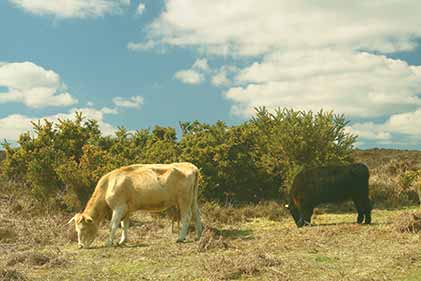Bee gardens

New Forest heathers – common heather, bell heather and cross-leaved heath - are all rich in nectar and pollen, and attract a wealth of insects, including a great many bees that can often be seen buzzing from plant to plant, thighs weighed down by the summer’s harvest.
In fact, until very recent times, hives were set out on some of the more remote heaths to encourage bees to forage amongst the heather. The honey produced is distinctively dark, has a delightful fragrance and is, of course, delicious.
Evidence remains of small, embanked enclosures that, it has been suggested, were used to protect the hives from damage by commoners’ stock, and deer.
Indeed, the New Forest Court of Swainmote in 1635 issued fines to those guilty of creating what were described as ‘small hedged enclosures’ for keeping hives on the open lands of the New Forest. Writing in 1923, Heywood Sumner said that this custom had died out in the early 19th century, but was ‘remembered as hearsay by old men now living’.
But John Wise, in the mid-19th century, noted that bees were at that time ‘still largely kept throughout the New Forest’, and went on to note that: ‘The bee-season, as it is called, generally lasts, on account of the heath, a month longer than on the Wiltshire downs.’
Wise did not mention the taste or fragrance of the honey, but remarked with some enthusiasm: ‘A great quantity of the Old-English mead…is still made, and is sold….at three or four times the price of common beer, with which it is often drunk.’
‘Hive’, ‘garden’, ‘garn’ and ‘bee’ place names indicate some of the locations where hives are thought to have been placed - as at Hive Garn Bottom, near Pitts Wood Inclosure, and Anthony’s Bee Bottom, near Holmsley.
References:
The New Forest: Its History and Scenery: John R. Wise.
A Guide to the New Forest: Heywood Sumner
Proceedings of the Hampshire Field Club & Archaeological Society, Volume 54 – The Earthwork Remains of Enclosure in the New Forest: Nicola Smith
More links
Other related links
Search this site

Sadly, 58 animals were killed - 35 ponies, 13 cows, 8 donkeys and 2 sheep, whilst a further 32 were injured - 3 pigs, 9 donkeys, 11 cows and 9 ponies.
(Forty-three accidents occurred in daylight, 15 at twilight and 101 in the dark. Twenty-seven accidents were not reported by the driver involved).
Here's just one horrific example - Three donkeys killed in collision with van at notorious New Forest blackspot (Advertiser and Times)

